Abstract
Electroencephalography (EEG) and magnetoencephalography (MEG) are widely used to localize brain activity and their spatial resolutions have been compared in several publications. While most clinical studies demonstrated higher accuracy of MEG source localization, simulation studies suggested a more accurate EEG than MEG localization for the same number of channels. However, studies comparing real MEG and EEG data with equivalent number of channels are scarce. We investigated 14 right-handed healthy subjects performing a motor task in MEG, high-density-(hd-) EEG and fMRI as well as a somatosensory task in MEG and hd-EEG and compared source analysis results of the evoked brain activity between modalities with different head models. Using individual head models, hd-EEG localized significantly closer to the anatomical reference point obtained by fMRI than MEG. Source analysis results were least accurate for hd-EEG based on a standard head model. Further, hd-EEG and MEG localized more medially than fMRI. Localization accuracy of electric source imaging is dependent on the head model used with more accurate results obtained with individual head models. If this is taken into account, EEG localization can be more accurate than MEG localization for the same number of channels.




Similar content being viewed by others
References
Barkley GL, Baumgartner C (2003) MEG and EEG in epilepsy. J clin neurophysiol 20:163–178
Birot G, Spinelli L, Vulliemoz S, Megevand P, Brunet D, Seeck M, Michel CM (2014) Head model and electrical source imaging: a study of 38 epileptic patients. NeuroImage Clin 5:77–83. doi:10.1016/j.nicl.2014.06.005
Brunet D, Murray MM, Michel CM (2011) Spatiotemporal analysis of multichannel EEG: CARTOOL. Comput Intell Neurosci 2011:813870. doi:10.1155/2011/813870
Christmann C, Ruf M, Braus DF, Flor H (2002) Simultaneous electroencephalography and functional magnetic resonance imaging of primary and secondary somatosensory cortex in humans after electrical stimulation. Neurosci Lett 333:69–73
Hamalainen MS, Sarvas J (1989) Realistic conductivity geometry model of the human head for interpretation of neuromagnetic data. IEEE Trans Biomed Eng 36:165–171. doi:10.1109/10.16463
Indovina I, Sanes JN (2001) On somatotopic representation centers for finger movements in human primary motor cortex and supplementary motor area. NeuroImage 13:1027–1034. doi:10.1006/nimg.2001.0776
Kober H, Nimsky C, Moller M, Hastreiter P, Fahlbusch R, Ganslandt O (2001) Correlation of sensorimotor activation with functional magnetic resonance imaging and magnetoencephalography in presurgical functional imaging: a spatial analysis. NeuroImage 14:1214–1228. doi:10.1006/nimg.2001.0909
Lascano AM, Grouiller F, Genetti M, Spinelli L, Seeck M, Schaller K, Michel CM (2014) Surgically relevant localization of the central sulcus with high-density SEP compared to fMRI. Neurosurgery. doi:10.1227/NEU.0000000000000298
Liu AK, Dale AM, Belliveau JW (2002) Monte Carlo simulation studies of EEG and MEG localization accuracy. Hum Brain Mapp 16:47–62
Malmivuo J (2012) Comparison of the properties of EEG and MEG in detecting the electric activity of the brain. Brain Topogr 25:1–19. doi:10.1007/s10548-011-0202-1
Martuzzi R, van der Zwaag W, Farthouat J, Gruetter R, Blanke O (2014) Human finger somatotopy in areas 3b, 1, and 2: a 7T fMRI study using a natural stimulus. Hum Brain Mapp 35:213–226. doi:10.1002/hbm.22172
Mazziotta JC, Toga AW, Evans A, Fox P, Lancaster J (1995) A probabilistic atlas of the human brain: theory and rationale for its development. The International Consortium for Brain Mapping (ICBM). NeuroImage 2:89–101
Ogawa S, Menon RS, Tank DW, Kim SG, Merkle H, Ellermann JM, Ugurbil K (1993) Functional brain mapping by blood oxygenation level-dependent contrast magnetic resonance imaging. A comparison of signal characteristics with a biophysical model. Biophys J 64:803–812. doi:10.1016/S0006-3495(93)81441-3
Scheler G et al (2007) Spatial relationship of source localizations in patients with focal epilepsy: comparison of MEG and EEG with a three spherical shells and a boundary element volume conductor model. Hum Brain Mapp 28:315–322. doi:10.1002/hbm.20277
Sharon D, Hamalainen MS, Tootell RB, Halgren E, Belliveau JW (2007) The advantage of combining MEG and EEG: comparison to fMRI in focally stimulated visual cortex. NeuroImage 36:1225–1235. doi:10.1016/j.neuroimage.2007.03.066
Singh KD, Holliday IE, Furlong PL, Harding GF (1997) Evaluation of MRI-MEG/EEG co-registration strategies using Monte Carlo simulation. Electroencephalogr Clin Neurophysiol 102:81–85
Waberski TD, Buchner H, Lehnertz K, Hufnagel A, Fuchs M, Beckmann R, Rienacker A (1998) Properties of advanced headmodelling and source reconstruction for the localization of epileptiform activity. Brain Topogr 10:283–290
Wolters CH, Anwander A, Tricoche X, Weinstein D, Koch MA, MacLeod RS (2006) Influence of tissue conductivity anisotropy on EEG/MEG field and return current computation in a realistic head model: a simulation and visualization study using high-resolution finite element modeling. NeuroImage 30:813–826. doi:10.1016/j.neuroimage.2005.10.014
Acknowledgments
Silke Klamer was supported by the fortüne-Programm (2055-0-1) of the University of Tübingen. The study was further supported by the AKF-Programm (289-0-0) of the University of Tübingen, the Center for Integrative Neurosciences and the Deutsche Forschungsgemeinschaft.
Conflict of interest
None of the authors have potential conflicts of interest to be disclosed.
Author information
Authors and Affiliations
Corresponding author
Rights and permissions
About this article
Cite this article
Klamer, S., Elshahabi, A., Lerche, H. et al. Differences Between MEG and High-Density EEG Source Localizations Using a Distributed Source Model in Comparison to fMRI. Brain Topogr 28, 87–94 (2015). https://doi.org/10.1007/s10548-014-0405-3
Received:
Accepted:
Published:
Issue Date:
DOI: https://doi.org/10.1007/s10548-014-0405-3




